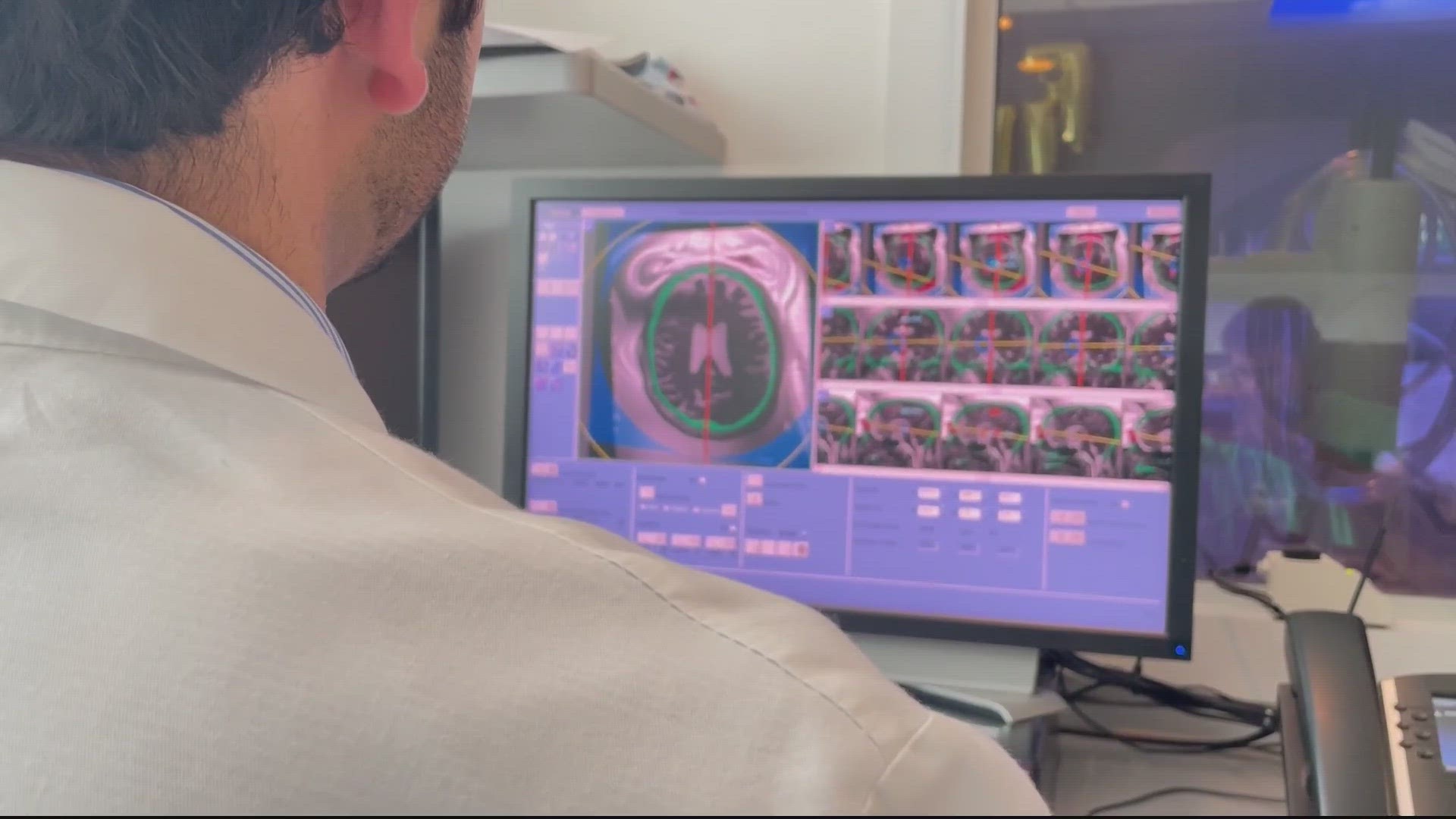CHARLOTTESVILLE, Va. — For centuries, surgeons have used scalpels, saws, and drills to cut into their patients and treat their illnesses.
But in the last few years, UVAHealth and a few other hospitals have pioneered what some are calling the most powerful sound you’ll never hear. It’s focused ultrasound, and it's being used to treat movement disorders without incisions or probes.
On the morning of his brain surgery at UVA in Charlottesville, 69-year-old Tony Farone’s tremor had left him unable to even fill out his patient forms.
Holding up his left hand and watching it shake uncontrollably, he said, "The longer it stays in that position, the worse the tremor."
The handyman, coach, and athlete was diagnosed with Parkinson’s disease almost a decade ago, after complaining his hand shook so badly, he couldn’t hold up a newspaper with his morning coffee.
"Now it’s gotten so bad, and the reason I wanted to have this procedure, is that it wakes me up at night," he said. "I don’t sleep but three or four hours a night."
Farone lives in Orange, Virginia, with his wife Liz Dole. He coaches lacrosse at Orange County High School. "It’s inconvenient to write, to eat, forget eating soup."
Farone is about to have a tiny hole burned in a neural pathway deep inside his brain to repair a circuit Parkinson’s has caused to go haywire. A health worker cuts off his flowing gray hair with a razor and screws a rigid metal frame to his skull. (This is the one part of the procedure where there can be a few drops of blood.)
“I’ve been doing this for several years, and even now, when I see [the results], it’s still such a good feeling for me. Still feels like a miracle,” says Dr. Shayan Moosa, the neurosurgeon who will treat Farone.
"Thank you baby," Farone says, as his wife gives him a kiss and workers lead him into a small room crammed with a big Magnetic Resonance Imaging device. "Alright," he says.
They stick a rubber cap on his head and then a huge helmet bristling with ultrasound devices. "If anything moves, we have to start all over," said Moosa.
They clamp the metal frame to a the MRI table and then a thousand beams of ultrasound are focused precisely on that narrow pathway in the brain, like a magnifying glass focuses light.
"That blue x is right on our target. So now we’re lined up exactly where we want to be," says Moosa, staring at a screen. He has the steady hands of a brain surgeon, but for this procedure, he's using a computer mouse to take aim, using landmarks on an image of Farone's brain to determine exactly where to focus the ultrasound.
Just a couple of low energy pulses designed to ensure they're in the right spot already ease Farone's symptoms. Moosa is seeing Farone’s tremor start to disappear even as they're just warming up.
"Can you count backwards from 10?" he asks Farone, who is awake and alert throughout. "10,9,8," Farone says, holding up his hands with barely a shake.
Now Moosa says it's time to "turn up the heat." A couple more pulses at a higher energy level, and it’s over, the whole thing taking barely two hours.
"What do you think about your tremor?" Moosa asks his patient. "I don’t like my tremor," Farone responds, apparently missing the point.
“You can see his tremor is completely gone, just like that," the doctor says.
Doctors say ultrasound is not a cure for Parkinson’s, a degenerative neurological disorder for which there is no cure. But it does treat one of the most disorienting symptoms. And that can make a huge difference for people.
"Hi! Look at you!," Farone's wife says with a huge smile as he's led out of the MRI room.
"Like a rock," says Farone, sipping from a tiny bottle of water. It's been seven years since he's been able to drink anything without spilling. "It’s like a miracle," he said.
The FDA approved focused ultrasound treatment for essential tremor in 2018. It's now expanding approval to treat Parkinson’s.
But already doctors at UVAHealth are experimenting with other diseases. “There are so many other possibilities with focused ultrasound, it’s really exciting,” said Moosa.
Brain tumors, like aggressive glioblastomas, chronic pain, even potentially psychiatric conditions, are all possibilities. At a lower temperature, ultrasound might help physicians get medications through the blood brain barrier that protects the brain, but also makes it tough to treat some conditions.
Farone expects to be back coaching lacrosse and working out in days, something that was tough to do with a tremor. Doctors say exercise is one of the best things patients can do to stave off the inexorable advance of Parkinson's. Farone hopes that he can keep his body in shape, he'll survive longer.
"If it kills me in a few years, I'm fine with that," he said. "As long as it doesn’t kill me now."
UVA neurosurgeon Jeff Elias just published the results of a randomized trial of focused ultrasound for Parkinson’s symptoms in the New England Journal of Medicine. 70% of the patients responded to the treatment. Most still saw benefits three months later, and many continued to see benefits a year later.
Side effects included trouble speaking, difficulty walking and loss of taste. Most issues resolved quickly, but one of the 69 patients still had slurred speech a year later.
Doctors can also treat tremors with deep brain stimulation, but that requires an invasive procedure to implant electrodes deep in the brain.
Some patients who were treated with focused ultrasound did see their symptoms return after awhile, but Moosa said those patients can potentially be retreated with ultrasound or get deep brain stimulation instead.

